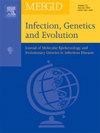河流沉积物微生物生态与抗生素耐药基因评估
IF 2.6
4区 医学
Q3 INFECTIOUS DISEASES
引用次数: 0
摘要
人为活动对卡伦河的影响很大,导致水质恶化。本研究利用环境基因组技术来描绘微生物种群,检查功能基因组学,并评估河流沉积物中毒力决定因素和抗生素抗性基因(ARGs)的发生。分类鉴定表明厚壁菌门是优势门,芽孢杆菌属是所有样品中数量最多的属。功能分析揭示了与沉积物相关的细菌的代谢能力,将它们与生物地球化学过程和潜在的健康影响联系起来。S2样品中毒力因子基因最多,而S3样品中ARGs基因最多(30个),突出了对致病性的关注。分析ARGs可为收集到的环境数据提供关键见解,例如水质参数(例如,营养物质浓度、pH值)或污染水平、这些耐药因素在沉积物样本中的流行程度和分布,有助于确定Karon河生态系统中抗生素耐药性的潜在热点。该研究在系统发育水平上发现了相似的操作分类单位(OTUs),表明某些微生物类群的存在是一致的。然而,在功能分类上缺乏差异表明,虽然这些分类群可能存在,但它们在代谢能力或功能角色方面没有显着差异。这些发现强调了宏基因组方法在了解水生环境中微生物生态和抗生素耐药性方面的重要性,表明需要进一步研究与ARGs和毒力因子相关的微生物功能恢复。本文章由计算机程序翻译,如有差异,请以英文原文为准。
Assessing microbial ecology and antibiotic resistance genes in river sediments
Anthropogenic activities greatly affect the Karon River leading to deterioration of water quality. This investigation utilizes environmental genomic techniques to delineate microbial populations, examine functional genomics, and evaluate the occurrence of virulence determinants and antibiotic resistance genes (ARGs) in fluvial sediment. Taxonomic assessment identified that Firmicutes were the predominant phyla, with Bacillus being the most abundant genus across samples. Functional analysis revealed the metabolic capabilities of sediment-associated bacteria, linking them to biogeochemical processes and potential health impacts. The S2 samples exhibited the highest virulence factor genes, while the S3 samples had the most ARGs (30), highlighting concerns about pathogenicity. Analyzing ARGs provides critical insights into environmental data collected, such as water quality parameters (e.g., nutrient concentrations, pH) or pollution levels, prevalence, and distribution of these resistance factors within the sediment samples, helping to identify potential hotspots of antibiotic resistance in the Karon River ecosystem. The study identified similar operational taxonomic units (OTUs) across sampling sites at the phylogenetic level, indicating a consistent presence of certain microbial taxa. However, the lack of variation in functional classification suggests that while these taxa may be present, they are not exhibiting significant differences in metabolic capabilities or functional roles. These findings emphasize the significance of metagenomic methods in understanding microbial ecology and antibiotic resistance in aquatic environments, suggesting a need for further research into the restoration of microbial functions related to ARGs and virulence factors.
求助全文
通过发布文献求助,成功后即可免费获取论文全文。
去求助
来源期刊

Infection Genetics and Evolution
医学-传染病学
CiteScore
8.40
自引率
0.00%
发文量
215
审稿时长
82 days
期刊介绍:
(aka Journal of Molecular Epidemiology and Evolutionary Genetics of Infectious Diseases -- MEEGID)
Infectious diseases constitute one of the main challenges to medical science in the coming century. The impressive development of molecular megatechnologies and of bioinformatics have greatly increased our knowledge of the evolution, transmission and pathogenicity of infectious diseases. Research has shown that host susceptibility to many infectious diseases has a genetic basis. Furthermore, much is now known on the molecular epidemiology, evolution and virulence of pathogenic agents, as well as their resistance to drugs, vaccines, and antibiotics. Equally, research on the genetics of disease vectors has greatly improved our understanding of their systematics, has increased our capacity to identify target populations for control or intervention, and has provided detailed information on the mechanisms of insecticide resistance.
However, the genetics and evolutionary biology of hosts, pathogens and vectors have tended to develop as three separate fields of research. This artificial compartmentalisation is of concern due to our growing appreciation of the strong co-evolutionary interactions among hosts, pathogens and vectors.
Infection, Genetics and Evolution and its companion congress [MEEGID](http://www.meegidconference.com/) (for Molecular Epidemiology and Evolutionary Genetics of Infectious Diseases) are the main forum acting for the cross-fertilization between evolutionary science and biomedical research on infectious diseases.
Infection, Genetics and Evolution is the only journal that welcomes articles dealing with the genetics and evolutionary biology of hosts, pathogens and vectors, and coevolution processes among them in relation to infection and disease manifestation. All infectious models enter the scope of the journal, including pathogens of humans, animals and plants, either parasites, fungi, bacteria, viruses or prions. The journal welcomes articles dealing with genetics, population genetics, genomics, postgenomics, gene expression, evolutionary biology, population dynamics, mathematical modeling and bioinformatics. We also provide many author benefits, such as free PDFs, a liberal copyright policy, special discounts on Elsevier publications and much more. Please click here for more information on our author services .
 求助内容:
求助内容: 应助结果提醒方式:
应助结果提醒方式:


